Tucked behind St Joseph’s Community Centre, the allotments recently celebrated its 13th birthday, and are managed by the Recreation and Amenity Department through Galway City Council. More than 30 plots make up this green enclave in the heart of the city.
David Biggins, chairperson of the Shantalla Allotments committee, has been involved since the beginning, when the site was little more than a pile of construction debris. He meets me in the car park outside the community centre, where residential homes frame the view and a helicopter whirls in the distance, bound for the UHG helipad which lays less than 100m from the gardens.
Maura Glennon is the Strategic Development Officer and has also been here from the start. She describes the space as a source of both wellness and community.
“It was a blank canvas,” Maura said, sitting at a recycled picnic table overlooking the plots. “From those first years we were all strangers, nobody knew each other, and I’d say 70pc of the people that came then are still here.”
“We’ve built up a very strong community of people, some of whom I would never have known where not for the allotments.”

Resident chickens sit in thier humble coops throughout the gardens.
Access to the fenced garden, with its 31 designated plots, was first granted by Galway City Council in the autumn of 2012 with support from the Shantalla Residents committee. The land has since been leased annually to the plot holders, and from the outset, the group worked together to shape a shared vision for the space.
“We formed a committee and that brought together people to build a shared vision on how we’d like to see the site developing. That has included bringing forward projects, mapping them out, writing proposals, getting funding for them, and building them.”
“It’s such a great partnership between city council and ourselves. It’s an example of when people share their goals and values, something like this can be brought into reality.”
Sustainable upgrades for a communal invitation
The garden’s growth has been supported through local enhancement programmes, amenity schemes and personal investment. Yet, both Maura and David say the best is still to come, with new plans focusing on accessibility, inclusion, sustainability and environmental innovation.
“We have plans to make it even lovelier than what it is now,” Maura said, “This is very much a work in progress.”
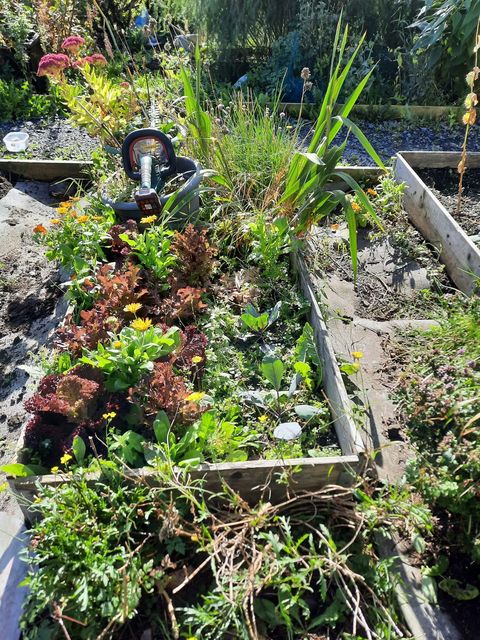
“The way the world is now, this is an incredible resource to have really is.”
Rainwater tanks dot the corners of the site, feeding a recycling system that has sustained gardeners for more than a decade. Bins are neatly labelled for composting, and future ambitions include a wheelchair accessible toilet built on-site, expanding the rainwater harvesting network, installing solar-powered lighting and creating an off-grid electricity supply.
“We’d like to expand the rainwater harvesting piece. We’d like to have even more of that,” Maura explained. “We’d like to get some electricity on site, maybe with solar panels.”
The wider vision includes transforming the garden into a true community hub.
“Ultimately, we’d like to see more of a community gathering space not just for ourselves, but for the wider groups around.”
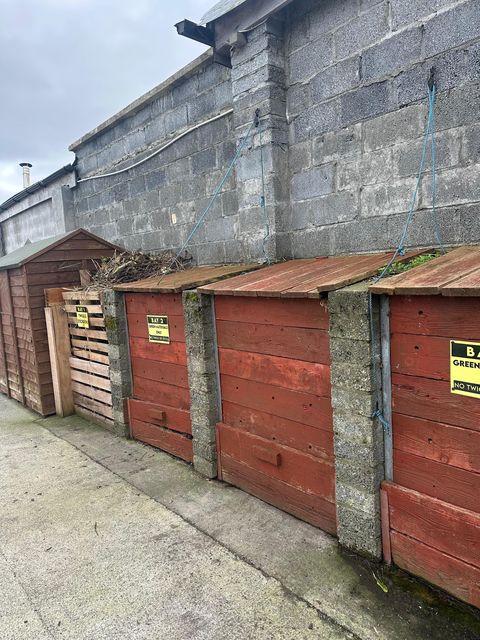
Combosting and rubbish bins for a circular sustainability model.
“The participation of Galway Simon Community as a partner plotholder in the allotments, already opens up access to many service users to a food growing space, and an opportunity to be part of the community of gardeners here.”
She imagines landscaped circular areas for poetry readings, yoga sessions and flower-arranging classes, perhaps even a pizza oven for community celebrations.
Growing past the seasons
Two years ago, the garden’s covered greenhouse received a much-needed facelift, becoming a highlight of the space. Each gardener has their own corner inside, where more delicate crops thrive.
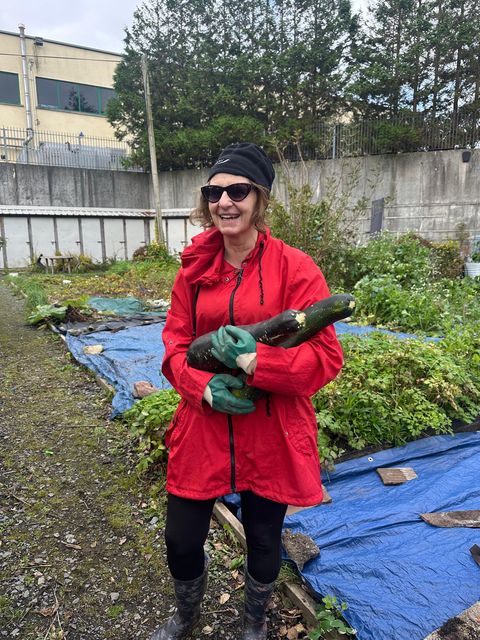
“The growing is the common connection. And then outside of that, it’s the bit of company and the bit of fun.”
Inside the hazy, humid structure, ripe tomatoes and chillies hang heavy on the vine. A wooden bookshelf stacked with gardening books sits beside a small formica table for two. David plucks a tomato from his plant and drops it into my hand.
There are two foods in this world that will discourage one from ever returning to store bought once you have eaten farm fresh: tomatoes and eggs.
David’s tomato proved the rule.
“It extends the season so we can start earlier and go longer,” Maura explained of the greenhouse. “It is great for social inclusion because each of us have a space in there, you end up having conversations and chats with different people because you’re in proximity there. There’s a lot of sharing with that.”
David jokes that when he retires in two years, he plans to spend his days sitting on those garden chairs. “I have plans,” he said, smiling to himself.
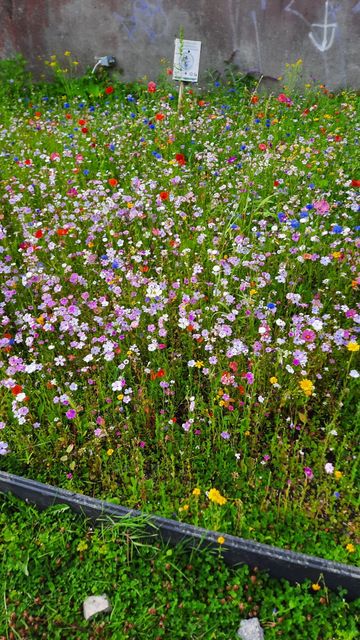
Pollinating flowers grow in the wildflower bed.
More than a ‘romantic idea’
Available plots get added to a list every two years where Galway residents apply to participate in random allocation draw. David said that having a garden is “a romantic idea” and, while no skills or experience is required to get on the list, he encourages interested parties to understand the hard graft it demands.
One nearby plot, whose previous owner recently passed away, has begun to overgrow, a reminder, Maura says, of the dedication needed to bring such a space back to life.
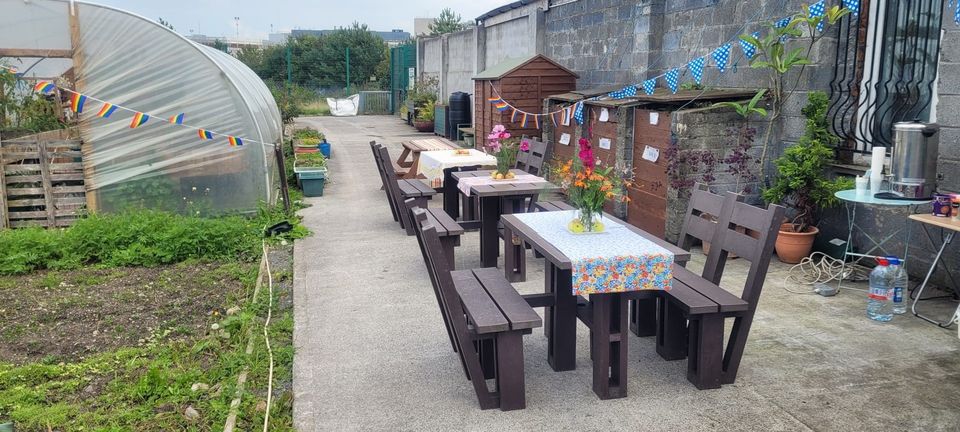
Community space in the gardens.
As we talk, it’s clear that the Shantalla Allotments are just getting started.
“The way the world is now, this is an incredible resource to have really is,” Maura said hoping the garden continues to be recognised as a “central resource for the city as an urban farm.”
For some, the garden is a way to grow organic food for the dinner table. For others, it’s a refuge from the world beyond the green gates. Whatever draws them in, friendship and community inevitably take root among the weeds and toil.
“Working in the soil, touching the microorganisms, there’s an energy in it that really all humans need. When you’re disconnected from it, you’re disconnected from wellness, really.”
“The growing is the common connection. And then outside of that, it’s the bit of company and the bit of fun.”
Available allotments are advertised in local newspapers, with details on how to apply.
Funded by the Local Democracy Reporting Scheme.


Comments are closed.